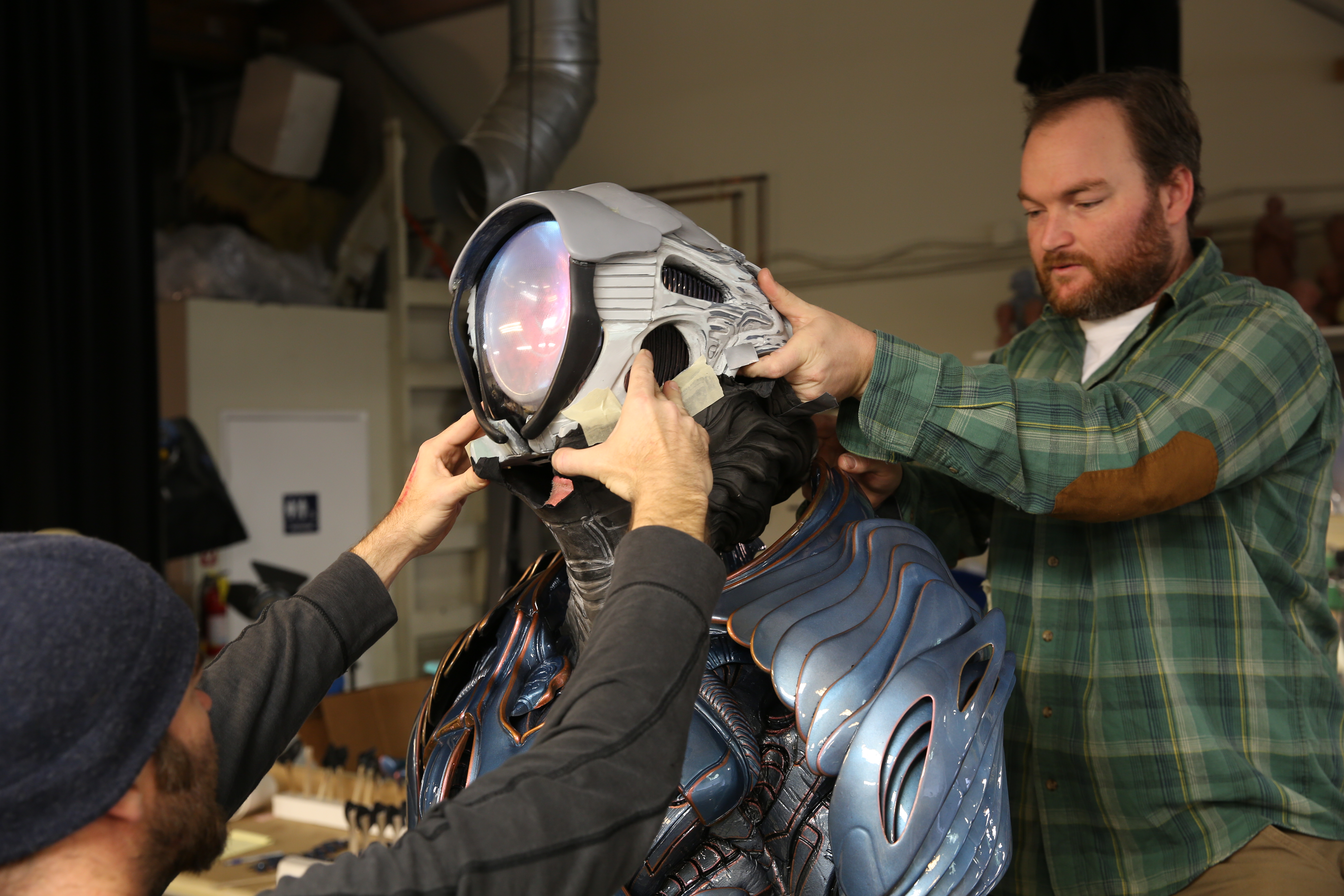Lost in Space: Inside the Creation of the Robot
Mike Elizalde and his studio Spectral Motion bring Netflix’s otherworldly creatures to life.
Yes, the creator of Netflix’s Lost in Space Robot knows you think it’s sexy.
Mike Elizalde is the owner and operator of makeup, prosthetic, and animatronics engineering studio Spectral Motion. Elizalde and Spectral Motion have worked with Star Wars: The Last Jedi director Rian Johnson on Looper and joined the league of monster-lovers with Guillermo del Toro on Hellboy and Hellboy II: The Golden Army.
It’s Elizalde and the studio’s work on two Netflix shows that have made waves most recently, however. Spectral Motion came to Netflix via season one of nostalgia-tinged mega hit Stranger Things. Spectral Motion brought the demogorgon to life – the big bad that gave a sinister new meaning to the phrase “flower power.” Then came Lost in Space Season 1 where the team realized the show’s vision of its own Robot. And as we all know, that vision turned out to be…appealing to the Internet.
“I think it’s great,” Elizalde says. “The aesthetic of the Robot is visually very beautiful and elegant. I think the performance combined with the visual really struck a chord with audiences.”
We spoke to Elizalde about working with Netflix, Guillermo del Toro, and what it’s like to be part of the Monster Fraternity.
Den of Geek: How did you get involved with Netflix?
Mike Elizalde: Stranger Things was our first project with them. Aaron Sims, the owner of Aaron Sims Creative, brought them to our doorstep. Aaron and I and several of my team members were together at Brett Baker’s studio for many years. We had a good relationship with them and it continues to grow.
What was the process of designing the demogorgon like? Did you have a lot of input from the producers and the Duffers?
By the time we were involved, Aaron and the Duffers were already dialed into what they were looking for. Aaron had done some renderings. That’s what we got. We got finished illustrations when we came into the game. We did a little bit of modifying so an actor could fit into the design and make the whole thing work practically. Our input was purely practical. It was about making sure our actor, Mark Steger, had room to perform and would fit within the silhouette of the character?
What are the nuts and bolts of the structure?
Our actor was 6’3. We augmented his height with stilts and the height of the head of the character is a little bit taller than Mark. That took him close to 7-feet stall. He was pretty imposing. It’s a spindly character with strange features. The suit was constructed by spandex, foam latex, and some other materials. We put a sheen material on top of the foam latex and an animatronic components for the flower petals to open and close and make the hands articulate. There was a fiberglass skull for Mark to wear the head. Aluminum, plastic, 3D printed components – we used all that too. As many of the tools that we have at our disposal we put in our design.
How are you able to make it feel so organic?
We have a very good team. Our team is led by me and then supervisors who take care of everything and department heads. One of our great collaborators is Mark Setrakian who designs all of the moving components. Mark has a very unique approach to the way he designs mechanical components. He then makes a mechanical system. That’s why the organic nature of what you see is so fluid and beautiful.
Were you guys brought back for season 2?
We didn’t come back for season 2. Once the demogrogon was wrapped and killed we were pretty much done. I did notice in the second season that I didn’t see a lot of practical components There was a lot of digital work.
Their giant mind flayer creature would have to be like $8 trillion to make practically.
Exactly.
How did the relationship with Netflix transition over to Lost in Space?
Again Aaron Sims, who did some of the early design work for the robot on Lost in Space brought our name forward and Netflix was sufficiently pleased with the work we’d already done for them. But Neil Marshall was also a connection. Neil was a very close friend with one of our team members here, Kevin McTurk. And the two of them had had some conversations. We had a good “in” so to speak.

What was your reaction when it became official that you would be working on the Robot – an iconic non-human character in TV history?
That was a concern that I had of course. I grew up watching the show myself. It was one of my favorites as a kid. The Robot was such a pillar of that storyline. He was such a central character. I was frankly concerned that if you changed it too much from that look or that design that maybe the audience wouldn’t embrace it. Netflix wisely chose to make the departure because guess what: the audience for that show isn’t old people like me that want to see their old friend The Robot. It’s a whole new audience. It’s a whole new couple of generations of people that really took to this design. The Robot was a very successful character in the story. It created a bit of a stir even. I’m not sure if you’re aware of the “hot Robot” thing that happened.
Oh yes. I was definitely planning on asking you about that. Why don’t you go ahead and expand? How did that make you feel – people finding the Robot sexy?
I think it’s great. We definitely had a great performer. Brian Steele who we’ve collaborated with many times in the past. He’s one of the most fit and can-do kind of actors that I’ve ever worked with. I don’t think it was too much enhancement that was required to get that kind of reaction. The aesthetic of the Robot is visually very beautiful and elegant. I think the performance combined with the visual really struck a chord with audiences.
You can just say the Robot’s sexy that’s fine.
(laughs) He is.
It sounds like you were trying to go with something completely new so maybe the original design didn’t factor in that much but what were some of the other influences?
The idea behind the Robot is that it’s alien technology that we don’t know that much about. You still want it to be relatable though. Especially for Will Robinson since they have such a close relationship in the show. Those were the factors that drove what it looked like. Then we took that and adapted that to a human body and to practical systems and how we could translate it to the scenes. He’s in the show quite a bit. I’m very proud of the amount of screen time he was able to get.
Did you take a look at the Lost in Space film from the ‘90s at all?
No, we didn’t. That was not a source of inspiration. We were working in a vacuum with new designs and a new team. Even the TV series – I’m not sure if that’s true for the rest of the production but as far as the Robot is concerned it was a whole new deal.
Do you get to be involved in season 2 in any capacity?
We’re definitely back for season 2. We’re currently during some work for the season, which I can’t talk about of course. But we’re definitely still part of the Lost in Space family.
What’s your day-to-day on set like? What’s the upkeep for the Robot?
The way this works is we have been tasked with creating the Robot and suggesting a performer and building the suit and creating a protocol for maintenance and performance. Once that is done the on-set duties are taken care of by the crew that’s there. It worked out that way because we didn’t create the thing so that it needed puppeteers on set. All it needs is maintenance.
How did you first get interesting in your industry? What fascinated you about movie monsters and special effects?
It’s been in my blood ever since I was a little kid. There isn’t a time where I can remember that I wasn’t fascinated by monsters or movie makeup. The cool genre stuff that we all grew up with and even before we were born. The Universal Monsters were a big influence on me as a kid. Nosferatu. Metropolis. These things were visually stunning moments in my childhood that I’ll never forget. It was mind-blowing when I saw 2001: A Space Odyssey as a nine-year-old kid. For weeks I was just reeling from that experience. It was so powerful. It was always something that stirred my soul and still does. There wasn’t one moment where I remember thinking “I want to be a movie monster guy.”
What is your favorite movie monster or creature?
That’s such a difficult question. If I had to narrow it down to one, it would be Frankenstein’s Monster. There are so many amazing, wonderful creations that have come since then that have such a deep influence on me: the American werewolf in London and The Thing – all of the great ‘80s monsters that were all practical. All of these beautiful creations have had their impact on my career path. If you had to take them all away and leave one it would be Boris Karloff.
Do you have any other Netflix or TV work lined up?
We do. I’m not at liberty to discuss any of this but we are collaborating on several film and TV projects at the moment. I will mention Guillermo del Toro is a producer on one of them. That’s always nice to get back in the saddle with Guillermo.
What is it like when a movie monster fan talks to Guillermo del Toro? Do his eyes light up?
Oh yeah. You know Guillermo. He’s a kid when it comes to monsters. That is one of his deepest loves and passions. He feels a real empathy for those characters and loves them dearly. It’s a love that we share. I always get very excited because his enthusiasm is contagious. He’s so devoted to doing it right. He wants to give these characters their just due: respectfully and elegantly. It’s terrific to have that kind of a director to work with and collaborate with.
Must be fun to be part of the monster fraternity.
It is.
